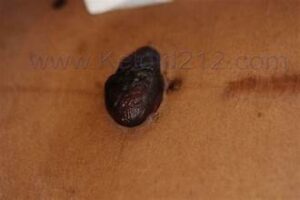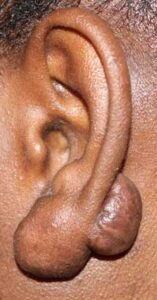Keloids are thick, raised scars that grow beyond the original injury—especially common in people with darker skin. Aglow Dermatology offers advanced treatments including injections, lasers, and surgery.
Concerned about a keloid or raised scar? Book an evaluation to learn about safe, effective treatments tailored to your skin.
Expert Care for Stubborn Scars
Keloids are a type of raised scar that develops when the body produces too much collagen during the healing process. Unlike regular scars, which typically fade over time, keloids continue to grow beyond the boundaries of the original wound. They often appear thick, raised, and can become itchy, tender, or even painful. Keloids are more than just a cosmetic concern — they can impact your confidence and quality of life. If you’re struggling with a keloid scar on your shoulder, an abdominal keloid, or even an ear keloid from a piercing, our expert dermatology team in NYC can help.

What Makes Keloids Different from Other Scars?
All scars are permanent. Any injury to the dermal layer of the skin will cause a scar. Keloids, however, are not like other scars. They are distinct in several ways:
- Keloids: Extend beyond the original injury site, grow over time, and can become large and raised.
- Hypertrophic Scars: Remain within the wound’s boundaries and may improve over time.
- Regular Scars: Flatten and fade naturally during the healing process.
The difference lies in the type of scar collagen produced. Keloids contain thicker, more disorganized bundles of type I and type III collagen, which contribute to their raised and expansive appearance.
Who’s at Risk for Keloids?
Keloids can affect anyone, but they are far more common in people with darker skin tones. African Americans, Hispanics, and people of Asian descent are at higher risk. Genetic factors also play a role — if you have a family history of keloids, you may be more prone to developing them.
Common Locations for Keloids
Keloids can develop anywhere on the body, however, they are unusual on the face. More likely places for the development of keloids includes:
- Ears: After piercings. Ear keloid removal is a common procedure.
- Shoulders: Following acne, surgery, vaccinations, or injuries.
- Chest and Back: From acne, surgical scars or other injuries.
- Abdomen: Abdominal keloids can form after surgery or injury. Many women get keloids after a c-section.
- Scalp and Neck: Some men who develop acne keloidalis nuchae or severe razor bumps develop keloid scars in this area of the body.

Keloid Treatment Options
At our dermatology practice, we offer advanced treatments to manage and remove keloids safely and effectively:
- Corticosteroid Injections for Scars: One of the most effective first-line treatments for keloids. These injections help flatten and reduce inflammation in the scar tissue.
- Laser Therapy: Helps to reduce the size and discoloration of keloids, making them less noticeable over time. This treatment can be combined with injection.
- Surgical Removal: For larger or more stubborn keloids, our team performs precise keloid removal with expert aftercare to minimize recurrence.
- Cryotherapy: Freezing the keloid to reduce its size and prevent further growth.
- Pressure Therapy and Silicone Sheets: Non-invasive methods to prevent keloid formation after surgery or injury such as pressure earrings.
Keloid Scars and Tattoos
If you’re considering a tattoo also consider your risk of keloid development. A tattoo injures the skin and stimulate this process.
Why See a Board-Certified Dermatologist for Keloid Removal?
Not all keloid treatments are the same — and improper care can worsen the condition. Our board-certified dermatologists will offer personalized treatment plans tailored to your skin type and scar characteristics.
Contact us today to schedule a consultation and start your journey to smoother, healthier skin.

